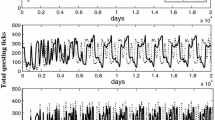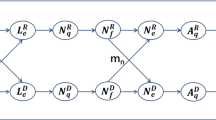Abstract
In this paper, we formulate a nonlinear system of difference equations that models the three-stage life cycle of the deer tick over four seasons. We study the effect of seasonality on the stability and oscillatory behavior of the tick population by comparing analytically the seasonal model with a non-seasonal one. The analysis of the models reveals the existence of two equilibrium points. We discuss the necessary and sufficient conditions for local asymptotic stability of the equilibria and analyze the boundedness and oscillatory behavior of the solutions. A main result of the mathematical analysis is that seasonality in the life cycle of the deer tick can have a positive effect, in the sense that it increases the stability of the system. It is also shown that for some combination of parameters within the stability region, perturbations will result in a return to the equilibrium through transient oscillations. The models are used to explore the biological consequences of parameter variations reflecting expected environmental changes.
Similar content being viewed by others
References
Awerbuch, T., Kiszewski, A., Levins, R., 2002. Surprise, nonlinearity and complex behavior. In: Health Impacts of Global Environmental Change: Concepts and Methods. pp. 96–102.
Awerbuch, T.E., Spielman, A., 1994. Role of host density in the ecology of Lyme disease. In: Axford, J.S., Reese, D.H. (Eds.), Lyme Borreliosis. Plenum Press, London, pp. 139–146.
Belozerov, V.N., 1991. Evolution of life cycles in ticks IXODIDAE due to climate seasonality. In: Dusbabek, F., Bukva, V. (Eds.), Modern Acarology. vol. II. SPB Academic Publishing BV, The Hague, Netherlands, pp. 135–139.
Constantino, R.F., Desharnais, R.A., Cushing, J.M., Dennis, B., 1997. Chaotic dynamics in an insect population. Science 275, 389–391.
Dennis, B., Desharnais, R.A., Cushing, J., Costantino, R.F., 1995. Nonlinear demographic dynamics: mathematical models, statistical methods and biological experiments. Ecol. Monographs 65, 261–281.
Grove, E.A., Kent, C.M., Levins, R., Ladas, G., Valicenti, S., 1998. Global stability in some population models. In: Proceedings of the Fourth International Conference on Difference Equations and Applications. Gordon and Breach Science Publishers, Poznan, Poland.
Gurney, W.S., Blythe, S.P., Nisbet, R.M., 1980. Nicholson’s blowflies revisited. Nature 287, 17–21.
Gyori, I., Ladas, G., 1991. Oscillation Theory of Delay Differential Equations with Applications. Oxford University Press, London.
Gyori, I., Trofimchuk, S.I., 2000. Global attractivity and persistence in a discrete population model. J. Differ. Equ. Appl. 6, 647–665.
Hassell, M.P., May, R.M., 1990. Population Regulation and Dynamics. Cambridge University Press, Cambridge.
Ivanov, A., 1994. On global stability in a nonlinear discrete model. Nonlinear Anal. Theory Methods Appl. 23, 1383–1389.
Karakostas, G., 1993. Convergence of a difference equation via de full limiting sequences method. Differ. Equ. Dyn. Sys. 1, 289–294.
Kocic, V.J., Ladas, G., 1990. Oscillation and global attractivity in a discrete model of Nicholson’s blowflies. Appl. Anal. 38, 21–31.
Kocic, V.J., Ladas, G., 1993. Global Behavior of Nonlinear Difference Equations of Higher Order with Applications. Kluwer Academic Publishers.
Kuang, Y., Cushing, J.M., 1996. Global stability in a nonlinear difference-delay equation model of flour beetle population growth. J. Differ. Equ. Appl. 2, 31–37.
Neubert, M.G., Caswell, H., 2000. Density dependent vital rates and their population dynamics consequences. J. Math. Biol. 41, 103–121.
Nicholson, A.J., Bailey, V.A., 1935. The balance of animal populations, Part I. Proceedings of the Zoological Society, London 3, 551–598.
Samish, M., Rehacek, J., 1999. Pathogens and predators of ticks and their potential in biological control. Ann. Rev. Entomol. 44, 159–182.
Sandberg, S., Awerbuch, T., Spielman, A., 1992. A comprehensive multiple matrix model representing the life cycle of the tick that transmits the agent of Lyme disease. J. Theor. Biol. 157, 203–220.
Sedaghat, H., 1998. Geometric stability conditions for higher order difference equations. J. Math. Anal. Appl, 224, 255–272.
So, J.W.-H., Yu, J.S., 1995. On the stability and uniform persistence od a discrete model of Nicholson’s blowflies. J. Math. Anal. Appl. 193, 233–244.
Yuval, B., Spielman, A., 1990. Duration and regulation of the developmental cycle of Ixodes damini (Acari: Ixodidae). J. Med. Entomol. 27, 196–201.
Author information
Authors and Affiliations
Corresponding author
Rights and permissions
About this article
Cite this article
Awerbuch-Friedlander, T., Levins, R. & Predescu, M. The role of seasonality in the dynamics of deer tick populations. Bull. Math. Biol. 67, 467–486 (2005). https://doi.org/10.1016/j.bulm.2004.08.003
Received:
Accepted:
Issue Date:
DOI: https://doi.org/10.1016/j.bulm.2004.08.003




